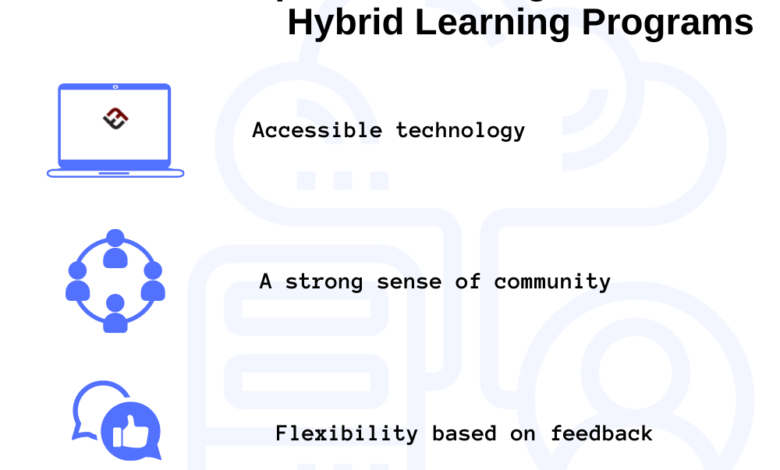The Role of Artificial Intelligence in Online Language Learning –

AI is quickly becoming a powerful change in online language learning (i.e., through eLearning), and it can significantly change how the material is delivered and how well learning systems work.
When AI is added to eLearning platforms, they become smart tools that customize learning experiences to meet students’ needs and run fun and useful training classes.
Let’s take a quick look at how AI is changing eLearning, what it can do, where it is being used now, and how it might be used in the future.
A unique experience for each person
Thus, one of the best things about AI-powered eLearning is its ability to provide personalized lessons. AI programs that analyze huge amounts of data about each student show them their habits, hobbies, and success. Because of this research, a sample program will be made that fits each student’s needs.
For example, well used, AI can address these concerns. It can figure out the topics the learner has the most problems with and provide them with extra links to articles, problems, or explanations in simpler terms.
Additionally, using an algorithm, these platforms can identify various courses and learning material that might interest the learner relative to the activities they have engaged in previously, similar to how the use of an algorithm suggests films or television shows to the learners.
This personalization helps boost learners’ interest and contributes to better learning. The learners face material that is neither too difficult nor too easy, so it does not challenge them.
Adaptive technologies
This phenomenon is also known as self-paced learning and is another sphere where AI is now used actively. Integrated teaching technologies may take lots of time to develop and incorporate into classes because traditional eLearning platforms provide standardized course delivery for all students, which can hardly meet individual needs and learning rates.
Smart learning technologies use AI, where the teaching material and learning level offered to the learner are continually modified depending on their performance.
Another benefit of the suggested learning process is that if the student performs well in some subject, the system can take the learner to the next level. On the other hand, if the learner is struggling, the system can recommend easier content or other practice exercises for improved completion.
This ability allows learners not to switch off or drop off while assisting them to complete their courses as desired, thereby enhancing their learning experiences.
Intelligent tutoring systems
Intelligent tutoring systems (ITSs) that use AI algorithms to assist learners are changing the learning support paradigm. These systems are designed to incorporate natural language processing (NLP) and machine learning to deliver personalized tutorials online. Additionally, ITS can provide human-like counseling in the tutor template, explaining concepts, answering questions, and giving comments.
For instance, an AI tutor assists a learner with a problem that requires mathematical computations. It guides the learner through the process while providing suggestions and feedback. This immediate feedback loop enables the learners to be conscious of their errors and the effects of making such mistakes, enhancing their mastery of the conent.
Moreover, ITS can run per shift around the clock, which means that learners can get support at any time that is suitable to them. This is advantageous, mainly as paced learning is incongruous with a normal classroom setting.
If you still prefer live tutors for learning foreign languages online, for example, online French tutors or others, they can also be easily found.
Improved engagement and interaction
AI also increases learner engagement and interaction through chatbots and Virtual Assistants. AI-integrated solutions can be utilized in eLearning to help bridge a gap between students and the course, responding to questions, supplying details, and instructing users on how to get around the system.
The conversation could be beneficial for handling simpler questions and concerns, such as registration for specific classes or IT-related questions, so the instructor would be free to address more constructive and valuable activities.
Increased NLP proficiency in virtual assistants indicates that AI-powered paradigms applied to learning can reach learners in a more personalized way. They can, for example, can provide questions and answers, set debates, or even create real-life cases for a training session. These features of the learning content can help make the practice less passive and, therefore, more easily retained by the consumer.
Data-driven insights and analytics
AI can now analyze tremendous eLearning data, such as platforms analyzing content and learners. Analyzing learners’ interactions, course completion rates, and performance enables the AI system to produce data that instructors and leaders can use to review the efficiency of the learning programs offered and the issues that necessitate attention. To reiterate, these evidence-based practices lead to new knowledge that can help make the necessary improvements in learning.
For example, it can provide information on learners’ behavior at certain points and problematic areas that are often poorly understood. This information can be helpful to educators in modifying teaching strategies, changing the curriculum, and administering more appropriate interventions for learners who may have difficulty grasping what is being taught. In addition, predictive type analysis can also determine future learning requirements and effects so that plans and resources can be made beforehand.
Scalability and efficiency
The flexibility of many AI-powered eLearning platforms is yet another strong selling point in their favor. Historically, to deliver education, there were structured or conventional modes of teaching that somewhat failed to meet the pace of development, especially in answering the learner’s needs across geographic regions. AI in eLearning helps the necessary electronic platforms provide learners with individualized and high-quality education with diverse learners at once.
Additional program functions, including grading, messaging (and other management activities), and tracking the learners’ progress, also improve operational effectiveness. AI systems can quickly and effectively complete these tasks by using algorithms, thus taking the load off educators and allowing them to work on higher-level creative processes. This efficiency not only brings down the companies’ operation costs but also enhances the level of education.
Challenges and future potential
As beneficial as it is, implementing AI in eLearning applications has drawbacks. Challenges visible in the current form of data-driven decision-making include data privacy, bias in algorithms, and the fact that it initially requires a lot of investment in information technology and infrastructure. Human concerns include the need to make AI systems as transparent, ethical, and secure as possible to gain the trust of learners and instructors.
When analyzing AI’s abundant potential in eLearning, it is important to look both to today’s classroom and the future. The evolutions in AI technologies, including deep learning and neonates, portray the future and more efficient learning tools in educational systems.
Eventually, it will be easier for AI to be combined with other umbrella technologies, including AR and VR; this will make lessons more real-life-like and involving than ever.
Source link




